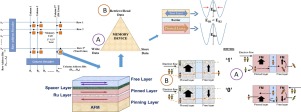当前位置:
X-MOL 学术
›
Mater. Today
›
论文详情
Our official English website, www.x-mol.net, welcomes your feedback! (Note: you will need to create a separate account there.)
Spintronics based random access memory: a review
Materials Today ( IF 24.2 ) Pub Date : 2017-11-01 , DOI: 10.1016/j.mattod.2017.07.007 Sabpreet Bhatti , Rachid Sbiaa , Atsufumi Hirohata , Hideo Ohno , Shunsuke Fukami , S.N. Piramanayagam
Materials Today ( IF 24.2 ) Pub Date : 2017-11-01 , DOI: 10.1016/j.mattod.2017.07.007 Sabpreet Bhatti , Rachid Sbiaa , Atsufumi Hirohata , Hideo Ohno , Shunsuke Fukami , S.N. Piramanayagam

|
This article reviews spintronics based memories, in particular, magnetic random access memory (MRAM) in a systematic manner. Debuted as a humble 4 Mb product by FreeScale in 2006, the MRAM has grown to a 256 Mb product of Everspin in 2016. During this period, MRAM has overcome several hurdles and have reached a stage, where the potential for MRAM is very promising. One of the main hurdles that the MRAM overcome between 2006 and 2016 is the way the information is written. The 4 Mb MRAM used a magnetic field based switching technology that would be almost impossible to scale below 100 nm. The 256 Mb MRAM, on the other hand uses a different writing mechanism based on Spin Transfer Torque (STT), which is scalable to very low dimensions. In addition to the difference in the writing mechanism, there has also been a major shift in the storage material. Whereas the 4 Mb MRAM used materials with in-plane magnetic anisotropy, the 256 Mb MRAM uses materials with a perpendicular magnetic anisotropy (PMA). MRAM based on PMA is also scalable to much higher densities. The paper starts with a brief history of memory technologies, followed by a brief description of the working principles of MRAM for novice. Reading information from MRAM, the technologies, materials and the physics behind reading of bits in MRAM are described in detail. As a next step, the physics and technologies involved in writing information are described. The magnetic field based writing and its limitations are described first, followed by an explanation of STT mechanism. The materials and physics behind storage of information is described next. MRAMs with in-plane magnetization, their layered material structure and the disadvantages are described first, followed by the advantages of MRAMs with perpendicular magnetization, their advantages etc. The technologies to improve writability and potential challenges and reliability issues are discussed next. Some of the future technologies that might help the industry to move beyond the conventional MRAM technology are discussed at the end of the paper, followed by a summary and an outlook.
中文翻译:

基于自旋电子学的随机存取存储器:综述
本文以系统的方式回顾了基于自旋电子学的存储器,特别是磁随机存取存储器 (MRAM)。MRAM于2006年作为FreeScale的一款不起眼的4Mb产品首次亮相,2016年已经成长为Everspin的256Mb产品。在此期间,MRAM克服了几个障碍,已经到了一个阶段,MRAM的潜力非常大。MRAM 在 2006 年至 2016 年间克服的主要障碍之一是信息的写入方式。4 Mb MRAM 使用基于磁场的开关技术,几乎不可能缩小到 100 nm 以下。另一方面,256 Mb MRAM 使用基于自旋转移扭矩 (STT) 的不同写入机制,该机制可扩展到非常低的维度。除了写入机制的不同,在存储材料上也发生了重大转变。4 Mb MRAM 使用具有平面内磁各向异性的材料,而 256 Mb MRAM 使用具有垂直磁各向异性 (PMA) 的材料。基于 PMA 的 MRAM 也可扩展到更高的密度。本文首先简要介绍了存储器技术的历史,然后为新手简要介绍了 MRAM 的工作原理。从 MRAM 中读取信息,详细描述了在 MRAM 中读取位背后的技术、材料和物理。下一步,将描述写入信息所涉及的物理和技术。首先描述基于磁场的写入及其局限性,然后解释 STT 机制。接下来描述信息存储背后的材料和物理。具有面内磁化的 MRAM,首先描述了它们的分层材料结构和缺点,然后是具有垂直磁化的 MRAM 的优点,它们的优点等。接下来讨论提高可写性和潜在挑战和可靠性问题的技术。本文末尾讨论了一些可能有助于行业超越传统 MRAM 技术的未来技术,然后是总结和展望。
更新日期:2017-11-01
中文翻译:

基于自旋电子学的随机存取存储器:综述
本文以系统的方式回顾了基于自旋电子学的存储器,特别是磁随机存取存储器 (MRAM)。MRAM于2006年作为FreeScale的一款不起眼的4Mb产品首次亮相,2016年已经成长为Everspin的256Mb产品。在此期间,MRAM克服了几个障碍,已经到了一个阶段,MRAM的潜力非常大。MRAM 在 2006 年至 2016 年间克服的主要障碍之一是信息的写入方式。4 Mb MRAM 使用基于磁场的开关技术,几乎不可能缩小到 100 nm 以下。另一方面,256 Mb MRAM 使用基于自旋转移扭矩 (STT) 的不同写入机制,该机制可扩展到非常低的维度。除了写入机制的不同,在存储材料上也发生了重大转变。4 Mb MRAM 使用具有平面内磁各向异性的材料,而 256 Mb MRAM 使用具有垂直磁各向异性 (PMA) 的材料。基于 PMA 的 MRAM 也可扩展到更高的密度。本文首先简要介绍了存储器技术的历史,然后为新手简要介绍了 MRAM 的工作原理。从 MRAM 中读取信息,详细描述了在 MRAM 中读取位背后的技术、材料和物理。下一步,将描述写入信息所涉及的物理和技术。首先描述基于磁场的写入及其局限性,然后解释 STT 机制。接下来描述信息存储背后的材料和物理。具有面内磁化的 MRAM,首先描述了它们的分层材料结构和缺点,然后是具有垂直磁化的 MRAM 的优点,它们的优点等。接下来讨论提高可写性和潜在挑战和可靠性问题的技术。本文末尾讨论了一些可能有助于行业超越传统 MRAM 技术的未来技术,然后是总结和展望。



























 京公网安备 11010802027423号
京公网安备 11010802027423号